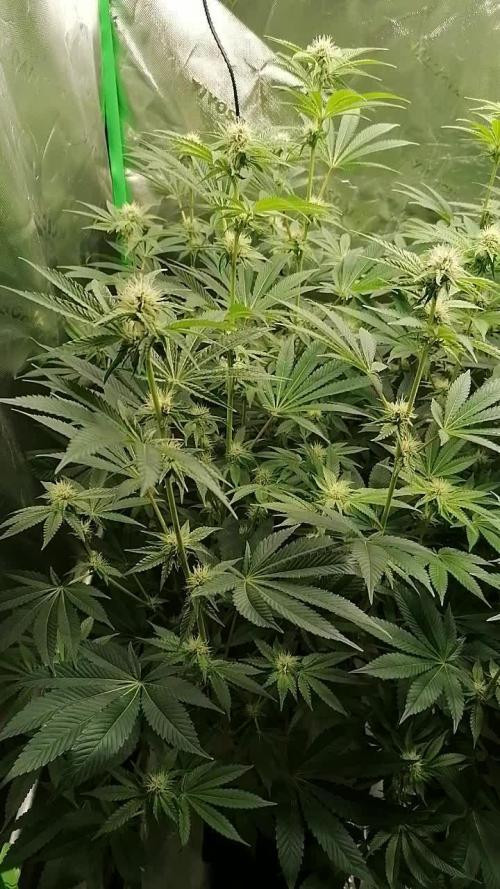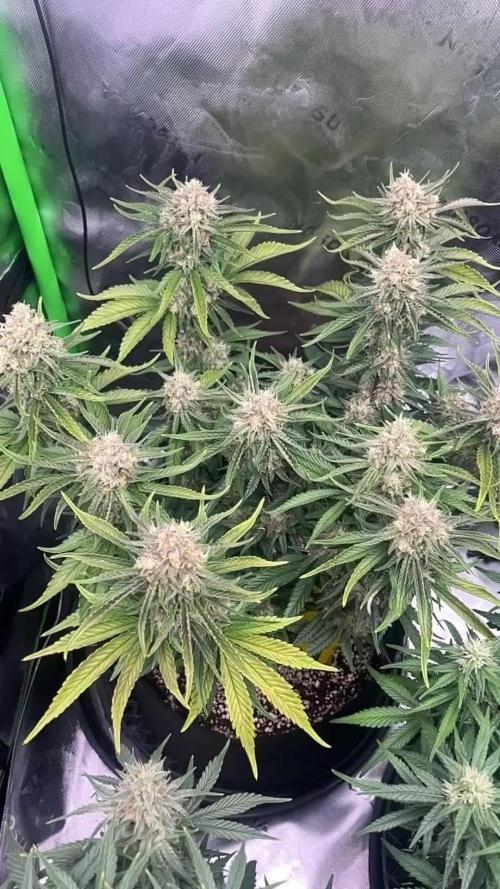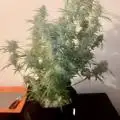The Grow Awards 2026 🏆 































Likes
Comments
Share


@Kynareth
Follow
Plants are still growing but more slowly now but they are healthy
I have to hst one more branche and its recovering good.
It's smelling more now and it's a reeeeeally nice smell, loving it.
Likes
16
Share


@Legionofroots
Follow
week 2 Established a nice root system in this clone, all ready for transplant. Used some azos on the roots and some in soil.
7/29- Added 250ppm of epsum salt and 250 ppm of calmag to 1 gal of water. Fed maybe 2 cups to the plant.
Likes
30
Share


@CanadianFillmore
Follow
Welcome growfessors to my outdoor 2021 grow! It's been 4 years since my last outdoor grow.
We've got LSD and Green Crack outside, each one in half a 55 gallon container, in pro-mix HP, with Gaia Green 4-4-4 all purpose powder nutrients.
Thanks for stopping by growfessors 👽🌳💚
Likes
26
Share


@Brujha77
Follow
Beginn 4. Blütewoche
Heute wurde nochmal entlaubt und es wurde einiges unten ausgeschnitten..
Da ich den Run mal wieder komplett waschen will, denke ich werd ich die 3. Nun so lassen.
Mal schaun ob sie ins Zelt passen💪😏
Likes
77
Share


@Ukfarmer420
Follow
Hi guys, so I chopped the little gelatocake 3 days ago and its hanging in 55% humidity and 15°f, I have taken a sample bud, you no how it is lol.
Sherbert mimosa are struggling along and going purple 💜 bit cold here lately, starting to fatten up a bit now, the baby photos are growing fast but need repoting.
Happy growing guys 💜💚💪
Likes
1
Share


@captaincondor
Follow
Well its been a good run with this pheno , she's the biggest plant i've grown so far and has excelled in bud production litterally everywhere. The shogun nutrients seem to have worked really well with no deficiencies throughout the grow . I've stop using dragon force now and am just feeding ph'd water for these final few days. I am looking forward to sampleing soon my gelato has also done really well with some nice dense buds
Likes
18
Share


@DudeGrowsWeed
Follow
July 11, 2024. 6’-9” & 6’-3”, average 6’-6”!!! They keep growing and growing and growing…👍
Had to increase watering to twice per day because they are thirsty girls!!!
Still supplementing Recharge and cal mag once per week. Otherwise it’s water only!!!👍👍
Likes
1
Share


@Cannerd
Follow
I'll be updating the comment with the daily log shortly, but figured I'd get the photos and weekly overview up.
I started off this week with a topping at about the 4th node, leaving the larger fan leaves on for now. I then left then alone for a bit while I waited for the new branches at the nodes to grow out, rotating as needed. By the end of the week, they had all bushed back up with new foliage and growth.
I also included photos pf the flowering mother plant to keep up with that sneak peak. She still wasn't showing signs of flowering, so I gave her an extra 24 hours of darkness to hopefully kick start the process. As I went to go shut unplug the light source, I noticed that there was a smaller light leak from one of the vent ports, so I also made sure to close that up. At the end of the week when she started to show signs of flowering, I defoliated her to help with light penetration, as she's got massive fan leaves. You'll see in the photos that I took that opportunity to decarb the trim as well. I'm sure there's little to no THC-A, but whatever other compounds are present should make for a nice addition to some butter later on down the road. I just won't factor it in when approximating the potency of the final product.
Likes
9
Share


@MG2009
Follow
12/16/2021
Recovery is a success! A little raggedy but putting on decent growth in last couple day's.
Also need to decide if I top or mainline the two tops? Going to feed her today and see how she grows this week then decide what action is appropriate.
She actually has 4 tops! Three are more developed but if you look closely there is 4. I kind of want to let it grow, although it may cause a split later on😕 . So still thinking on it.
Likes
4
Share


@Wescoas
Follow
I thought the ladies would have another 2-3 weeks left in veg, but started to notice pistils forming within the last couple of days. So flower will most likely start to begin within the next week, I’m guessing I may see a couple oz per plant come harvest day. Not bad for first time grow & using autos, from what I’ve heard a lot of people do not recommend learning with autos due to how quickly their state can change depending on what you do with them. There are some things I wish now I would have done a bit different within the last couple of weeks, I can’t help but wonder how much bigger they’d be if I did not do any defoliation at all. But I have been combating flies bad and made the call to defoliate mainly for that reason. Started to cut back on veg foods and introduce flower foods and sugars to their diet. Humidity levels still at a steady decrease, aiming to have humidity down in the 30s come flower time. Will be going on vacation for a week soon, so fingers crossed that nothing goes wrong. Will be having a good friend of mine come by every couple of days to FaceTime me and make sure everything is handled as well as possible when the time comes.
Likes
12
Share


@WeedBetweenTheLineYT
Follow
Boosting the bloom on this girl for this week going hard into it trying to really push them flowers to fill up. She is definitely starting to get thicc tho definitely excited for the coming weeks when I feed her heavy and fatten her up I’m sorry I’m a cannabis feeder lol
Likes
39
Share


@Growergreg
Follow
Potted up four gorilla girl xl in to 5 gal pots, using plagron light mix.🇬🇧
moistened the The soil gently in advance with 1l regular tap water and 4ml root juice. Using gloves pushed the seed just under the soil. dusted over With a bit more soil, added A tiny bit more water gently as possible and finally covered with humidity domes
*Day 2, all four seeds germinated over night, chuffed! removed Humidity domes
*Day 3, Two of the Four seeds are expressing yellowing, one just Having 1 yellow leaf. I’m guessing this was down to the seed case partially being stuck. and or bad ph. Ph up and down on route.
*Day 4, mixed up a litre of cal-mag buffed Tap water, left out to dechlorinate/come to room temp and watered accordingly. Plant’s #1 and #2 progress. Plant 3# yellow leaf dropped. Plant 4# stunted but think she’ll be ok
*Day 5, gave mini feed bio- grow and cal-mag then ph to 6.0. I changed the light cycle to 18hrs on, 6 off also
*Day 6, possible nitrogen toxicity:/, just water from now
Likes
11
Share


@Chubbs
Follow
420 Fastbuds
FBT2303 Week 6
This week has been exciting for sure. Both have definitely transitioned into flower now, showing flower sites everywhere. They both are growing very similar as far as height,look, and leaf structure goes.Had some calmag issues but I think we got that under control by upping the feeding to 1tsp per gal. Over all I'd say Happy Growing.
Likes
11
Share


@CocoLogic
Follow
Sept 20th: (F34)
Fertigation once a day with NEW recipe (1300 EC 6.1 PH) watered until 10-20% run-off
Sept 21th: (F35)
Fertigation once a day with same recipe (1300 EC 6.1 PH) watered until 10-20% run-off
Sept 22th: (F36)
Fertigation once a day with same recipe (1300 EC 6.1 PH) watered until 10-20% run-off
Sept 23th: (F37)
Fertigation once a day with same recipe (1300 EC 6.1 PH) watered until 10-20% run-off
Sept 24th: (F38)
Fertigation once a day with same recipe (1300 EC 6.1 PH) watered until 10-20% run-off
Sept 25th: (F39)
Fertigation once a day with same recipe (1300 EC 6.1 PH) watered until 10-20% run-off
Sept 26th: (F40)
Fertigation once a day with same recipe (1300 EC 6.1 PH) watered until 10-20% run-off
Likes
51
Share


@Chumpkilla
Follow
1/21/24 - Day 76 - Everything is looking good still. Today is water change day! This time i was out at the box during the change. Everything went well. I did install a new temperature sensor to replace the old one. Also I installed a new C, and PH- bottle.
1/23/24 - Day 78 - I noticed the buds are starting to fatten up. They kind of grow in little nodules sticking out from the main bud site. Its really cool to see. I added some pictures up top! Ill update on some more pictures in the next couple of days.
1/25/24 - Day 80 - The buds are getting fatter and the smell is getting super pungent. Everything is going as planned. I need to start scoping it to check for color. We are still a long ways from starting the flush but it time to start looking!
Likes
15
Share


@Polomatic
Follow
This week the temperature rised a few degrees, so the lamp had to be lifted 5 cm to keep things not so warm (around 27.0 ºC.
Still using Big Bud, Bud Candy and Powder Feeding Long Flowering.
The Cream Mandarine F1 and the Azure Haze odor is getting sweeter everyday!
























